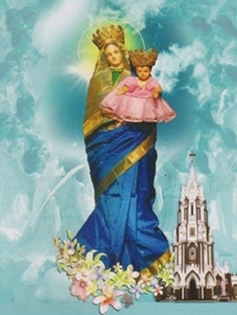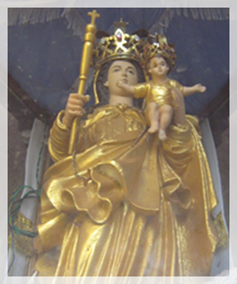☦ About Church
The formation of the city of Bangalore and the formation of St.Mary's Church are found to be interlinked with the History of Karnataka. During the 17th Century, few Christians came
from Gingee, of Tamil Nadu, found that the land was fertile to sow white rice and began to settle down and built a small village. This village took the name 'Biliakkipalli'
because it is said that the rice they cultivated was white and also because a number of white birds were found in those rice fields. The people in order to practice their
religion built a thatched hut and named it as 'CHAPEL OF KANIKKAI MADHA'.
The Italian Jesuits of the Malabar Mission were the founders of the Mysore Mission in the 17th Century, who were succeeded by the French Jesuits from Madura and Carnatic
Missions in the 18th Century.
In 1799, Fr. Jean Dubois came in lay dress with the English troops at the siege of Srirangapatna and only when he celebrated the Mass in the church, people did recognize
him as a Catholic Priest. When the Cantonment was established in the Bangalore, the Christians, both Europeans and Indians were attending the Mass celebrated by
Fr. Jean Dubois. In 1811, he built a small chapel with a residence for priests.
Later on, Rev. Fr. Andreas an Indian priest from Pondicherry succeeded him and he expanded the Church building in the shape of Cross.
In 1832, due to some communal riots, the church was pulled and pillaged. Fr. Beauchaton, the Parish Priest, narrowly escaped death by the tactful handling of the situation
by the Christian people. Troops arrived to restore peace and the government had the Church guarded first by the European soldiers and later by Indian sepoys for many
months. After some years a great plague spread throughout the Biliakkipalli region. The people sought the intercession of Mother Mary to relieve them from the clutches of
disastrous death. Mother Mary interceded for the victims and the plague vanished from the vicinity. Since she cured the people from the dreadful disease and gave them
goodhealth, she was also called as 'Annai Arokiamarie' (Our Lady of Good Health).
In June 1875, the construction of the present Church began during the time of the then Parish Priest, Rev. Fr. E.L. Kleiner, who later became the Bishop of Mysore. In view of
the historic importance of St. Mary's Church, the then British authorities from Delhi were paying a grant every year for the maintenance of the church till 1948.
The present Church of St. Mary's built by Rev. Fr. Kleiner was solemnly consecrated on 8th September 1882 by Msgr. Joannes Maria Y. Vicar Apostolic of Mysore, in the presence of
35 priests and about 4000 Catholics of Bangalore. It is interesting to note that, all the other parishes of Bangalore were born out of this ancient parish of St. Mary's Church.
It was during the tenure of Most. Rev. Dr. P. Arokiaswamy, the then Archbishop of Bangalore and Rev.Fr. Paul Kinatukara, the then Parish Priest of Mary's Church, with the strenuous
efforts of the Archbishop Most. Rev. Dr. D. S. Lourdusamy, the then Secretary General for the Sacred Congregations for Evangelizations of peoples at Rome, Holy Father Pope Paul VI,
elevated
St. Mary's Church to the title of "ANNAI AROKIAMMARIE BASILICA' on 26th September 1973, which was officially announced and celebrated on 26th January 1974. Since then, every year this
day stands as a remarkable significance of God's grace. For several years a grand car procession carrying the Eucharist was organized and the archbishops administered solemn blessed
of the Blessing Sacrament.
Due to increase in the population, and more devotees flooding to visit the shrine of Our Lady, the space that was available for the devotees to stand and pray was found to be very
congested. At this juncture, the then Parish Priest, Rev. Fr. T. Jabamalai, successor of Rev. Fr. Paul Kinatukara, constructed a hall like structure facing east and placed the
statue of Our Lady in a prominent place. This enabled thousands of devotees to see her without any hindrance and pray to her more devotedly. During the year 2004 - 2007, the
church was completely renovated by him and was rededicated on 29th August 2006 by the Archbishop of Bangalore, and that year (1882-2007) it celebrated 125th year of
its consecration. During the month of June 2007, the Church and Shrine was bifurcated His Grace the Archbishop of Bangalore appointed Rev. Fr. A.S. Anthony Swamy as the
Parish Priest and Rev. Fr. L. Arulappa as the Rector of the Shrine. On 8th of September 2007, Annual feast day and birthday of Blessed Virgin Mary, His Grace the Archbishop
officially declared this Basilica as the Diocesan Shrine.
DESCRIPTION OF THE CHURCH
St. Mary's basilica is a spacious gothic Church, designed by a French architect and built in the form of a Cross. It is 172 feet long and 50 feet broad.
The imposing and magnificent tower forming the fašade of the Church is 160 feet high. A beautiful statue of Mother Mary holding Child Jesus in her harms, 6 feet in height,
is set up in a an attractive shrine just outside the Church building, is the chief object of veneration and source of inspiration for the people. Every day is draped in 'Sari'
the typical dress of the Indian lady. It is said that in 1875 when the new Church was built, people tried to remove this statue in order to install it on a prominent altar inside
the Church, but they failed in their effort since the statue remained immovable. This strange happening is considered even today as a sign of Our Lady's miraculous power.
☦ Novena Prayer

☦ Miraculous Statue of Our Lady

At the main entrance of the Shrine you will find another Statue of Our Lady, a smaller one, which has a story behind it.It is believed to have happened in the year 1832,when
the Church was attacked by some miscreants and every thing was destroyed except this small statue. It is also said that when they attempted to pull it down, they were struck
blind. Soon police and military contingents arrived on the scene and restored clam just when the mob had set fire to the Church. The statue thus miraculously saved,
is the one that is placed in animposing, flower decked, illuminated palanquin taken in procession during the important days of Marian devotion. It is true that for
several years even Muslims were in the habit of taking out in solemn procession, the same statue of Our Lady
|